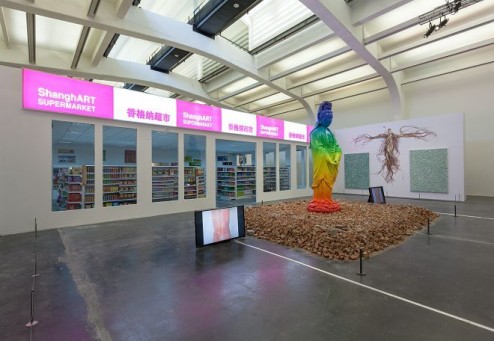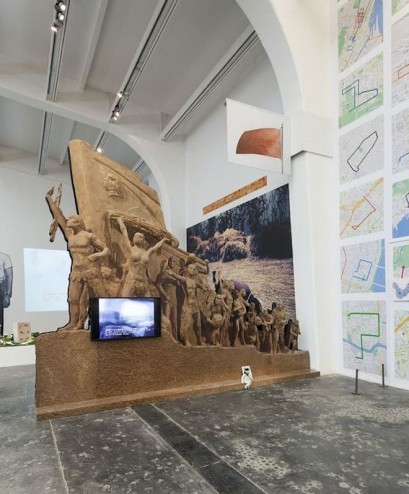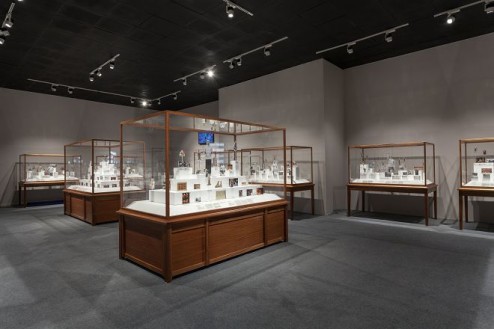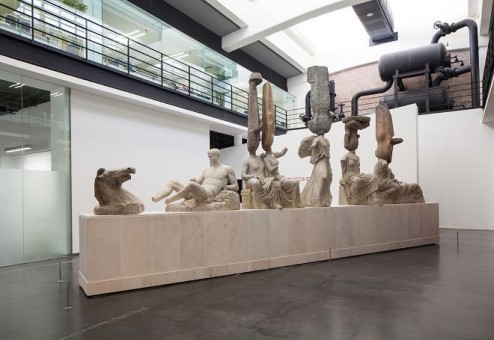Xu Zhen, The Catcher of Consciousness
According to Randian’s ethics policy, I would like to disclose that I was involved in the translation of texts for the exhibition discussed.
Though the space at UCCA is stretched unavoidably thin by the sheer volume of Xu Zhen’s retrospective, the exhibition, which cost millions to orchestrate, allows the artist and MadeIn to present a relatively complete picture of all of the activities and projects in which they’ve engaged over the years. The show’s most highly anticipated piece, ShanghART Supermarket (2007), is a small store built to realistic dimensions standing at the center of the exhibition hall, selling shiny packaged goods that are in fact empty. These “products” are to be sold according to the amounts on their price tags; on the day of the exhibition’s opening, supermarket cashiers in uniforms found themselves terribly busy as audience members vied for the artworks—incidentally probably the cheapest things UCCA has ever had to purchase. In the rest of the exhibition, everywhere one turns there are volunteers in blue and white hospital gowns wordlessly trailing or circling viewers—a reprise of Xu Zhen’s 2002 performance installation “March 6”. For people unfamiliar with the work, its appearance here will be a bit disconcerting; for those who observed or participated in Tino Sehgal’s conversational art piece “This Progress” in the same space last year, it shouldn’t pose a problem.
Xu Zhen/MadeIn Company’s work leaves audiences with the impression of something unexpected, something fun, a sort of doggerel of images—even a visual comedic monologue. The colorful form of Guanyin, Buddhism’s goddess of mercy, sits not on a throne of lotuses but rather atop a pile of rubble (New, 2014); what at first seems to be a monument to the People’s Heroes is not a troupe of revolutionary comrades but rather a group of primitive early humans (The struggle of man against power is the struggle of memory against forgetting, “True Image” series, 2010); the neck of what would-be exquisite porcelain vase is bent to a right angle, instantly dwarfing its elegance (“MadeIn Curved Vase” series, 2013) ….
But all this speaks to only one facet of Xu Zhen; his art is not, in fact, as easily accessible as it appears—not because his work, like other conceptual art, exudes the philosopher’s temperament in all its untouchably otherworldly, highbrow splendor—but ironically due to just the opposite; the challenge of Xu Zhen’s works lies in the fact that they could fit absolutely any interpretation that might be applied to them. Physique of Consciousness (2012) serves as a good example. A few years ago, MadeIn Company collected hundreds of artefacts found in various social, religious, and political situations and used them for a “consciousness fitness routine.” Each glass vitrine in Physique of Consciousness is labeled with a single action, with everything within it corresponding to this action. For example, all of the internet-downloaded pictures in the “Hand over Mouth” vitrine show this specific gesture in a wide variety of incarnations, through ancient and modern times, in China and abroad, and so on. There is an image of a small Mexican religious figurine covering its mouth; there is an image of a present-day activist, lips sealed over in protest. It seems that the plan here would be to reveal, through an ethnographic lens, the historical origins of all of these universal gestures passed down over the generations—or, in the words of the Company, to “explore the nature and source of our ideologies by creating parallels between our social, religious, and political beliefs.” But perhaps MadeIn’s thought process was not so profound in the end; perhaps this was all merely a decoy built in exchange for the labor of collecting a large amount of pictures. On the one hand, we could be asking whether these subjectively interwoven “clues” can truly ensure a connection between a common action, a prehistoric carving, and a religious ritual (the sort of question that also happens to be the Achilles’ heel of Carl Jung’s “collective unconscious”). On the other hand, there may be no need for us to raise the interpretation of the work to the heights of cultural and physical anthropology; when it comes to Xu Zhen’s art, the second you take things too seriously is the second you lose. Maybe what Xu Zhen hopes to instill with his work is a magical effect, as opposed to a magical principle. From this angle, we can begin to feel out the troublesome balance he strikes, somewhere between solemnity and sense of humor.
It is not difficult to extract several other artists’ names from MadeIn Company’s work. The “supermarket” piece brings with it associations to Takashi Murakami-esque commercialism; the “rubble” formation of Calm (2009) reminds us of the democratic elements of Felix Gonzalez Torres’ “Public Opinion” the “dinosaur” evokes a Damien Hirst-like thrill; and “The Bourgeoisie Is Not Interested in the Mad, But It Is Interested in Power over the Mad” (2011) echoes Jennifer Bolande’s plywood curtains. We even find, here and there, some of the wild imagination inherent in Gabriel Orozco’s current exhibition at Gallery Faurschou (a reprise of the artist’s 1993 tire strip installation, La DS). All the same, explaining Xu Zhen’s operation itself is not easy, and attempts to do so often find themselves tangled up in the mix of Xu Zhen the artist, Xu Zhen the artistic director, Xu Zhen the artistic contractor, Xu Zhen the boss of MadeIn Company, Xu Zhen the MadeIn Company brand, and now Xu Zhen the gallerist.
Considering the exhibition as a retrospective, the way in which the works have been installed seems to be out of order and a little bit off. The show’s internal logic gives way to its spatial layout, trying as hard as it can to maintain a level of cohesiveness. The result is that we are unable, through viewing the exhibition alone, to identify a temporal sequence with regard to Xu Zhen and his group’s ideational evolution. It is difficult to find a developmental trajectory to Xu Zhen’s creative ideas—how he went, for instance, from “Rainbow” (1998) (a video of the increasingly reddening back of a man being repeatedly beaten) or “Shouting” (1999) (a video featuring pedestrians’ startled reactions to the loud cries of the artist behind the camera) to his work today. Nor is there a way to grasp the connection between each phase of his work and the era to which it corresponds. Additionally, the way the works are presented lacks reason. The workout equipment in “Untitled” (2007), for instance, ought to be placed on the ground so that audience members can actually use it, with others operating the remote control; only in this way can the truth of the work emerge. At UCCA the equipment has been set on a high platform, in such a way that the piece loses its meaning completely. What’s more, a few of Xu Zhen’s most representative works have somehow not been included at all, a fact which is decidedly regrettable. His “Potala Palace” built out of poker cards (Untitled, 2009), his life-scale model dinosaur split into two halves (“Untitled,” 2007), and the Chinese minibus that he turned into a giant washing machine (“Comfortable,” 2004) are all absent.
With a closer look, it becomes clear that Xu Zhen’s successes are due not only to healthy operations, robust capital flow and excellent promotional work, but also to another factor that is not easy to overlook: a difference in the times. The stretch of time that has passed from Xu Zhen’s earliest works at the end of the last century to the varied work produced by the company mechanism today is actually not that long, but it has coincided with a golden age of growth for contemporary art in China. Camp culture, shanzhai culture, and the extreme consumption of recreation and entertainment have endowed artwork like Xu Zhen’s with utmost relevance. Nobility and grandeur have stepped down from the altar; a sense of mystery, an air of suspense, all of the other once-revered qualities of art have one by one devolved into targets of public ridicule. In contrast with the strong emphasis on a sense of individualized symbolism as seen in Zhang Xiaogang’s portraits, Cai Guoqiang’s explosions, Xu Bing’s text works, and even Zhao Zhao’s panels of glass which were shot by a gun, it is obvious that Xu Zhen is much more “cunning” with his work. His pieces always appear to be in a constant state of flux—the paths they take are unpredictable and hard to pin down—but this is, in fact, their own latent “symbolism” peeking through: it just happens to be more deeply concealed. The nature of Xu Zhen’s work plays on and with consciousness. It is as if the artist has left us with a brainteaser. The only difference is, he presents us with both the riddle and the secret to solving it all at the same time.
Most of all he stops us in our tracks with the effect of flash bulb bouncing a world-famous painting (reproduction), forcing us to squinting our eyes and image where and what the “lightsource” might be (“Light Source,” 2013). He causes us to split our sides laughing as we watch a video of people cutting 1.86 meters off the snowy peak of “Mount Everest” which we are told that was actually a farce staged on a gallery roof in the summer of 2005 (“8848-1.86,”). It’s in these moments that is seems entirely possible that Xu Zhen has had these “aha moments” set in his sights all along.
Visit Randian website for more images here






 Back to Index
Back to Index